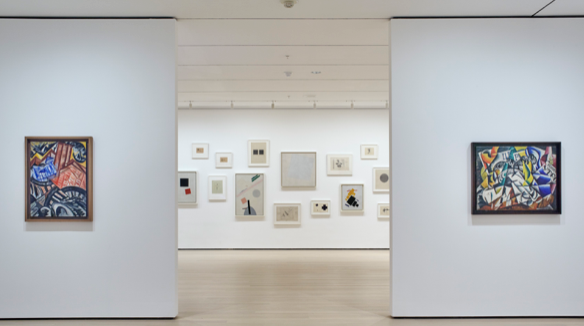
Installation view of A Revolutionary Impulse: The Rise of the Russian Avant-Garde. The Museum of Modern Art, New York, December 3, 2016-March 12, 2017. © 2016 The Museum of Modern Art. Photo: Robert Gerhardt
A Revolutionary Impulse: The Rise of the Russian Avant-Garde; curated by Roxana Marcoci and Sarah Suzuki with Hillary Reder; Museum of Modern Art, NYC, through March 12
Review by Roann Barris, Radford University
One might be excused for thinking that the entry sign to the exhibition is one of the art works in the show. The assertive, sans serif lettering, which increases in scale, and the angled parallelogram with a circle at its end, speak to the dynamic sense of velocity created by the art of the Russian avant-garde. This economy of design is also seen in El Lissitzky’s cover of Wendingen: barely four forms, two lines, and the title angled between the lines and oriented in the same direction as the grey rectilinear slab. The thin lines continue from the front cover to the back. Indeed, one of the most exciting features of this exhibition is the ample inclusion of such print works, which also includes an array of LEF magazine covers, books designed by Lissitzky, and illustrations by Olga Rozanova. Of course, one cannot overlook the wall of marvelous movie posters by the Stenberg brothers or the room of movies where the films of Sergei Eisenstein, Dziga Vertov, and others, are continuously projected.
Upon entering the exhibition, two things are especially striking: first, the extent of MoMA’s holdings in Russian art is a veritable history of the avant-garde. Simply stunning in its depth and quality, much of it is never on view. We know that Alfred Barr began collecting Russian art on his trip to Russia in the late 1920s, but less widely known is the degree to which this collection continued to grow throughout the twentieth century. A second and equally strong impression is one of synergy. Regardless of medium and artist, there is a recognizable direction of development. There is nothing random or haphazard about the evolution of Constructivism and Suprematism. Yet, isn’t this how we tend to think of it: as an avant-garde that is not held together by style because the artists affirmed that they were against style? Perhaps this show teaches us that style in this case refers to an attitude about velocity, angularity, a sense of dynamism, and most important, about the communication of ideas through composition.
The New York Times art critic, Roberta Smith, welcomed this show for another, but equally important, reason. In her December 9 assessment of the exhibition, she noted the role of this exhibition as marking a revolutionary change in how the Museum of Modern Art chooses to display its art. Thus, she concludes that a second revolutionary impulse can be observed–-one which, in this case, suggests an approach to exhibitions that is broad, pulls on the entire collection of the Museum, and enables visitors to see just how the synergy I described previously characterized this moment in Russian art.
The graphic design media may be the most impressive works of all. Although they are not likely to look very different in real life, rarely do we have the opportunity to see so many copies of the radical LEF journal laid out in one place at the same time. Another high point is seeing so many works by one artist together on a single wall or filling a room – the Lissitzky Proun room, for example, and the wall of prints by Lyubov Popova. The individual works may not be newly surprising (although in Popova’s case, they are), but it increases their resonance when so many are seen together. Surely, the artists themselves were aware of this effect as they worked in series.
A viewer unfamiliar with Russian art is in for an exciting surprise. The visitor who has devoted years to studying this period will also be surprised in a different way – namely by that feature of resonance and the almost dizzying profusion of seeing so many works of Russian art in one place.
-
A Revolutionary Impulse: The Rise of the Russian Avant-Garde is on view at The Museum of Modern Art, New York, December 3, 2016-March 12, 2017.
Roann Barris, a professor of art history and Art Department chair, has long been interested in Russian theater and graphic design. Not long ago, she returned to Moscow where she reexamined the materials she had used in her doctoral research on Russian constructivism, and revised much of what she had originally believed.